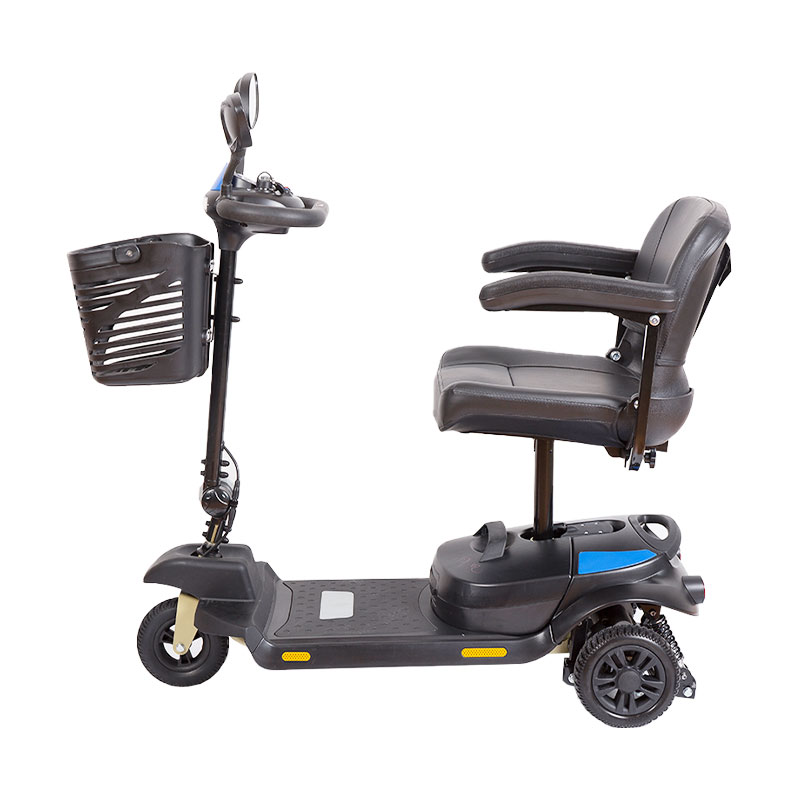How do 3 wheels elderly mobility scooters handle torque and acceleration?
Three-wheel elderly mobility scooters handle torque and acceleration through a combination of motor design, electronic control systems, and mechanical features. Here’s a detailed explanation of how these factors work together to provide a smooth and controlled riding experience:
Motor Design
Type of Motor:
Brushless DC Motor (BLDC): Most modern mobility scooters use BLDC motors due to their efficiency, reliability, and low maintenance. These motors provide consistent torque and smooth acceleration.
Geared Motors: Some scooters use geared motors to enhance torque output, especially useful for handling inclines and starting from a stop.
Electronic Control Systems
Motor Controller:
Pulse Width Modulation (PWM): The motor controller uses PWM to regulate the power delivered to the motor, controlling acceleration and torque. By adjusting the duty cycle of the PWM signal, the controller can smoothly increase or decrease motor speed.
Current Limiting: To prevent excessive torque that could cause wheel spin or instability, the controller limits the current supplied to the motor. This ensures that acceleration is gradual and manageable.
Throttle Control:
Variable Speed Throttle: The scooter typically features a variable speed throttle, often in the form of a twist grip or thumb lever. This allows the rider to adjust acceleration smoothly, providing precise control over speed.
Electronic Throttle Management: The electronic control unit (ECU) interprets throttle input and adjusts motor output accordingly, ensuring a responsive yet controlled acceleration profile.
Mechanical Features
Transmission and Gearing:
Direct Drive or Geared Transmission: Direct drive systems offer a simpler design with fewer moving parts, providing reliable torque transfer. Geared transmissions can offer higher torque at lower speeds, beneficial for climbing slopes or starting from a stationary position.
Differential: In some three-wheel designs, a differential mechanism ensures that power is distributed evenly to the wheels, especially important for handling turns smoothly.

Torque and Acceleration Management
Torque Sensing:
Sensor Feedback: Sensors monitor parameters such as wheel speed, motor current, and throttle position. This feedback is used to adjust torque output dynamically, ensuring smooth and controlled acceleration.
Adaptive Algorithms: Some advanced scooters use adaptive algorithms that adjust torque and acceleration based on real-time conditions, such as changes in terrain or load.
Acceleration Profile:
Gradual Ramp-Up: The control system is programmed to ramp up the motor power gradually when the throttle is engaged, preventing sudden jerks or excessive torque that could destabilize the scooter.
User-Selectable Modes: Some scooters offer different driving modes (e.g., eco, normal, sport) that adjust the acceleration profile and torque output to suit different preferences and conditions.
Safety Mechanisms
Anti-Tip Features:
Center of Gravity Management: The scooter's design ensures a low center of gravity, enhancing stability during acceleration. Anti-tip wheels or mechanisms may be included to prevent tipping during sharp accelerations or turns.
Speed Limiting: To enhance safety, the scooter may limit maximum speed and acceleration when navigating steep inclines or uneven surfaces.
Braking Integration:
Regenerative Braking: Some scooters use regenerative braking systems that recover energy during deceleration. This system also provides controlled deceleration, complementing the torque and acceleration management.
Automatic Braking Assistance: When excessive torque or rapid acceleration is detected, the system can engage braking assistance to prevent loss of control.
By combining advanced motor design, sophisticated electronic control systems, and thoughtful mechanical features, three-wheel elderly mobility scooters are able to handle torque and acceleration in a manner that ensures smooth, safe, and reliable operation for users.


 English
English Deutsch
Deutsch







-3.jpg?imageView2/2/format/jp2)
.jpg?imageView2/2/format/jp2)






